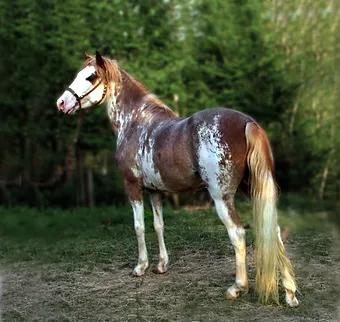Sabino 1 (SB1)
Gene or Region: KIT
Reference Variant: A (N)
Mutant Variant: T (SB1)
Affected Breeds: Many
Research Confidence: High Confidence - Mutations in KIT have been well-documented to cause white spotting in both the horse and other species
Explanation of Results: SB1/SB1 = homozygous for Sabino 1, extreme trait expressed SB1/n = heterozygous for Sabino 1, trait expressed n/n = no variant detected
General Description for Sabino 1
Sabino 1 is a variant of the KIT gene that causes the sabino (or sabino overo) spotting pattern. Sabino 1 is an example of incomplete dominance, indicating that horses that inherit one copy of the allele have different phenotypes than horses with two copies. Heterozygous horses (SB1/n) generally have extended white markings on the legs and face, sometimes with a belly spot and roaning (white hairs) throughout the body. The borders of the white markings tend to be fairly jagged. Sabino horses commonly have dark colored eyes. Homozygous horses (SB1/SB1) are born nearly to completely white.
The sabino spotting pattern is found in many breeds of horse, however not all horses with this phenotype have the SB1 allele. For example, several draft horse breeds have spotting patterns that are nearly identical to SB1/n horses, such as the classic Clydesdale markings. Many of these sabino-like patterns do not produce completely white offspring.
Genotype and Phenotype
Maximum Sabino / Sabino White (SB1/SB1) [Color] Sabino (SB1/n)
- Spotting patterns generally follow after the color of the pigmented regions, for example “chestnut sabino” or “grullo sabino.”
- Sabino is sometimes called “sabino overo” or simply “overo.”
- In some breeds, horses with at least one tobiano allele and any overo pattern are called “tovero.”
Gene Information
KIT is a tyrosine kinase receptor that is vital for normal development. Mutations in other species have led to white spotting, anemia, sterility, and certain types of tumors. However, no negative health effects associated with KIT mutations have ever been documented in the horse. The SB1 mutation alters a splice junction, which then results in the absence of a portion of the protein.
References
Brooks SA and Bailey E. “Exon skipping in the KIT gene causes a Sabino spotting pattern in horses.” (2005) Mamm Genome. 16: 893-902.
More Horse Color Genetics
Congenital Stationary Night Blindness & Leopard Complex
Congential Stationary Night Blindness (CSNB) is characterized by the inability to see well in low light and no-light situations. It is linked to Leopard Complex Spotting (LP), where homozygous horses (LP/LP) will have CSNB. Congential Stationary Night Blindness is present at birth and is non-progressive.
Champagne
Champagne (CH) is a dilution that affects all coat colors. Champagne foals are born with pink skin and blue eyes that slightly darken with age. Adult champagne horses have a distinct pumpkin colored skin with mottling in the hairless regions, as well as amber/green/tan eyes. Horses with multiple dilutions can be difficult to accurately identify color without genetic testing.
